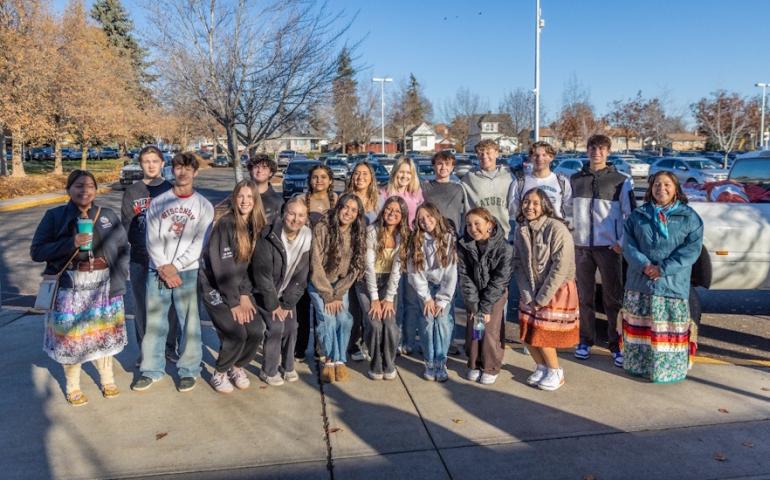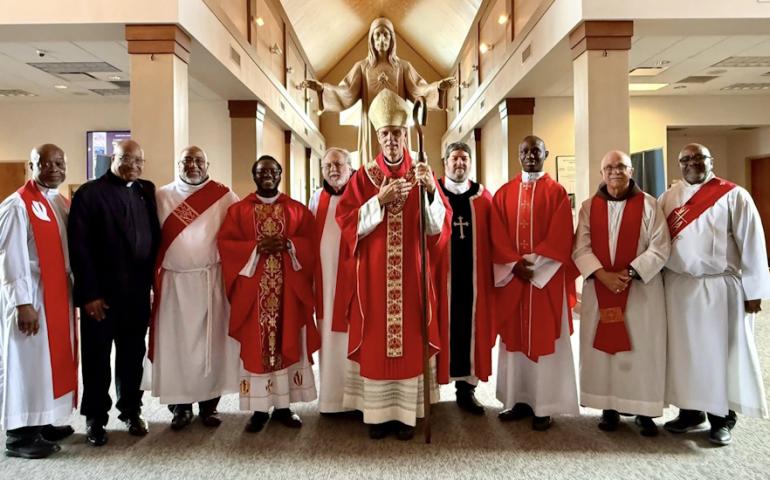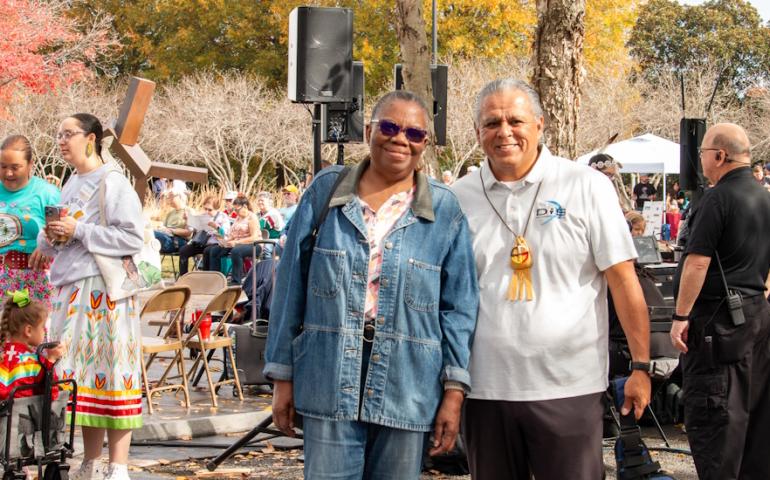Standing Rock Reservation Ministry
The road between McLaughlin and Bullhead is paved with asphalt now, one of the few improvements on the Standing Rock Reservation that Sr. Jacque Schroeder found when she returned to ministry here in 2016.
The 70-year-old Franciscan sister from the Diocese of Peoria first arrived on Standing Rock 23 years ago. She has spent a dozen years of her life ministering in northwestern South Dakota among the Lakota people she loves. Her first stint began in 1996, back when the Milton Brown Otter Memorial Highway was just 14 miles of gravel road leading to St. Aloysius Catholic Church in Bullhead, a village of 400 people nestled in the valley of the Grand River. Sr. Jacque still recalls the hot summer day when she swerved to avoid a Long Horn steer that had ambled up out of the road ditch, losing control of her car on the loose gravel. The car rolled several times, tumbling over a fence and landing in a field. But she was wearing a seatbelt and walked away from the accident with only a bruised elbow and a small cut on her forehead.
“My guardian angel called in reinforcements that day,” she says.
Sr. Jacque left in 2004 but returned to the reservation in 2016 as part of the Standing Rock Reservation pastoral team for the Diocese of Rapid City. The team also includes Sr. Mathilde Osomba-Akatshi, another Franciscan sister from the Democratic Republic of the Congo, and the Rev. Jim Hoerter, a diocesan priest. Together, they minister to three small parishes in McLaughlin, Kenel and Bullhead, as well as the larger community of 4,165 residents of Corson County. Standing Rock Reservation straddles the North Dakota-South Dakota border and is home to at least 8,600 people. Native Americans tend to be undercounted by the U.S. Census so those numbers probably underestimate the tribal population.
While the roads may be in better shape today, other things on the reservation have gotten worse, Sr. Jacque says. The condition of the Catholic Church is among them.
Parish membership is down and church attendance has fallen dramatically in the last 20 years. Funerals are common place in the churches. Weddings, baptisms and confirmations are not.
St. Bernard’s Catholic Church in McLaughlin, population 633, consists mainly of non-Native farmers and ranchers, Indian Health Service retirees like Rosemary Verbanac and business owners, like Bruce and Shirley Moser. The Mosers own the only grocery store in town. Verbanac recalls the time when the St. Bernard Altar Society had 80 or 90 members. Today, there are just 18 Altar Society members. The parish is aging, not growing. It has 77 registered households and 145 Catholics, including 26 children. But on any given Sunday, there may be 40 people at Mass.
At St. Aloysius in Bullhead, and Assumption of Our Lady Church in Kenel, the numbers are even lower. Kenel is a small unincorporated village named for Fr. Martin Kenel, one of the Benedictine missionary priests who began serving Standing Rock in 1876. The town was once 100 percent Catholic and still boasts 57 households registered at Assumption. Today there are rarely more than about 15 faithful parishioners in the pews for 11 a.m. Mass on Sundays. Elaine St. John, the 91-year-old matriarch of the parish, is always one of them, but her great-grandchildren are not. The Bullhead parish claims 37 registered households and 80 parishioners, but only a handful attend Mass on Sundays.
At the invitation of then-Bishop Robert Gruss, the Franciscans joined the pastoral ministry team in 2016 in an effort to reverse those trends. They came, knowing they would face social and spiritual challenges. They found them.
Violence and crime are up. A young man was beaten to death in December 2019 in McLaughlin, while walking near the Bear Soldier South housing division. Alcohol and drug addiction, especially methamphetamine, is pervasive. The 20-year-old grandson of a parishioner hung himself earlier in 2019 during a meth-induced depression. “Meth addiction just blankets the reservation. I don’t think there is a family that is not affected by it,” Sr. Jacque said. Tragedy and grief are daily realities.
And, yet, she felt a strong pull to return to Standing Rock. “I can’t explain exactly why. I’ve always felt a kinship with the people of South Dakota.” Perhaps it can be traced to a childhood memory of attending a pow wow during a family vacation. “I remember sitting on the lap of an old Indian man and he felt very grandfatherly to me,” she said. Perhaps it is knowing the great needs that exist here. Or perhaps it is something as simple -- and as powerful -- as a call from God.
“I felt a deep call, and I took Bishop Gruss’s invitation as a call from God,” she said. “While discerning the question of returning to Standing Rock, what I kept hearing from God was, “Trust me.” Coming back was a walk of trust, really.”
The pastoral team has few illusions about what it can do to combat all of the social problems and physical poverty that is rampant on the reservation. But team members believe deeply that their Presence is an important weapon in the battle against spiritual poverty on Standing Rock.
“The mission up here requires community life, not only for the sisters, but also as a witness to the people here. The witness of community life is far more important than any one thing we do,” she said.
The two Franciscans perform all the usual parish ministries in Kenel, Bullhead and McLaughlin, where the sisters make their home in the St. Bernard rectory. Fr. Jim lives in the renovated convent located a block away. They bring Holy Communion to the elderly and homebound; do hospital visits in nearby Mobridge and Bismarck, 80 miles to the north; they teach religious education or vacation Bible school to youth and offer faith formation classes for adults. Ellen Woodard is one of two people currently enrolled in RCIA classes at St. Bernard’s Church. Woodard, 78, is former Lutheran who will be confirmed in the Catholic faith at Easter time. She suffered a stroke three years and has other health problems so she moved to McLaughlin to live with a daughter and found comfort in daily Mass at St. Bernard’s. “I was going to the Lutheran church here in town, but they only met two times a month. I rely heavily on God, so I kept coming back to here.”
Like so many people on the reservation, Woodard appreciates the sisters’ warmth and hospitality. “They are so welcoming, and that means a lot to people.”
But with fewer people in the pews, Sr. Jacque and Sr. Mathilde are looking for new ways to rebuild church and do community outreach. This approach to ministry begins, they say, by rebuilding trust and relationships, one person at a time. It is slow work that requires time and patience.
“It all comes down to one-on-one ministry,” Sr. Jacque believes. Whenever possible, the pastoral team has begun spending all day Tuesday in Bullhead, Thursday in Kenel and Friday in Wakpala, a community about 20 miles southeast of McLaughlin that lost its Catholic church in 2016. The sisters host communal meals and prayer. They knock on doors, seeking to visit and get to know the people and their needs, inviting people to return to church and inquiring what caused them to stop coming in the first place. Many don’t even answer the door, but those who do often tell her, “I know I should be there.”
The causes of falling church participation are many and complicated, but Sr. Jacque believes a loss of a sense of community and the lack of a true Lakota identity for others is partially responsible.
More than 42 percent of people on Standing Rock live below the federal poverty level, and child poverty rates are at nearly 55 percent. “But physical poverty has always been a reality here. Everybody was poor,” Sr. Jacque said. “The real poverty is not knowing who you are: loss of cultural heritage, loss of tribal values, … and the loss of a faith and church community.” That type of poverty often makes people too ashamed or too angry to answer the door when she knocks.
The cluster of Standing Rock parishes was also chosen to be part of a new diocesan Mental Wellness Ministry that launches in 2020. The ministry will provide education and trainings about mental wellness issues in a partnership with the Catholic Social Services agency in Rapid City, and also be a parish-based ministry of accompaniment for those who are struggling with mental wellness issues of all kinds, both chronic mental illness and more situational issues, such as the loss of a loved one.
In addition, Sr. Mathilde started a Grief Recovery Ministry at St. Aloysius in November. The 8-week class began with a small pilot group that includes Georgia and Eileen. The two Lakota women are dealing with the many losses – from death, but also from broken relationships -- that they have accumulated over their lives. Eileen shares a photo of herself and her three sisters, taken in the 1970s, with the group. All of her sisters are gone now, and the grief group helps her cope with the loneliness of being the sole surviving sibling.
Georgia shares memories of her father. “I lost my dad when I was 5 years old,” she says. “To be honest, I started to come to Sr. Mathilde’s bereavement group just to support it. But I found it has been really helpful and very meaningful for me. I’m getting to know my dad for the first time, by sharing memories of him.”
The four women sit around a table in the parish hall at St. Aloysius and talk about things like “relationship graphs” and “completion letters.” The letters they write include apologies, forgiveness and emotional statements that are designed to help them say goodbye to relationships that remain unresolved, whether by death or in life. Class members pray, read, light candles, complete a lesson and do an activity on grief. They share homework from the previous week, all in a confidential small-group setting. They talk about their losses, and listen to each other. “It’s not my job to fix anyone. It’s my job to listen,” says Sr. Mathilde.
The decision to approach their ministry this time around from the “grief angle” is an important one, Sr. Jacque says.
“Literally everyone is grieving. It’s layers of grief. It’s generational grief,” she said.
Sr. Mathilde is the “perfect person” to lead the grief ministry, according to Georgia Andre, one of the participants. “Her culture is very similar to ours. She’s so authentic.”
Sr. Mathilde had never even heard of South Dakota, and did not know what a reservation was, before being assigned here. “I’m happy to be here. I came from a small village, a tiny town, so when I came here, it is like I’m home. It’s similar.”
She joined the Sisters of St. Francis of Assisi of Tshumbe right after high school graduation and celebrated her 25th jubilee in 2013. The 9th of 13 children, Sr. Mathilde says she knew she wanted to be a nun by the time she was 5 years old.
She speaks Tetela, her native language, and French, the official language of the Democratic Republic of Congo, but learning to speak English at the age of 55 has been her biggest obstacle. “English is my challenge.” She’s also taking driving lessons from the team, but once the snow falls lessons will have to wait until spring.
Sr. Mathilde comes from a poor African village where her grandfather was a Catholic catechist. Her family converted to Catholicism generations ago in Africa. Her story mirrors that of St. Aloysius parishioner Ron Brown Otter. Brown Otter is a Lakota Catholic who owns the 20,000-acre Brown Otter Buffalo Ranch near Bullhead, where he runs 500 head of buffalo and has created a successful Native-owned business. Brown Otter and his wife, Carol, move easily between the Lakota and Catholic communities. His great-great grandfather was Hairy Chin, a Lakota medicine man who converted to Catholicism. Generations of Brown Otters have been Catholic ever since.
Through his great-great grandfather, he feels a connection to Nicholas Black Elk, a Lakota catechist who is being considered for canonization by the Catholic Church. A story that was passed down through oral tradition in his family, and told to him many times by his mother, claims that when Black Elk was still a youth, he assisted Hairy Chin as he performed a Lakota healing ceremony on an Indian warrior who had been shot in the hip by a U.S. Army soldier. Afterwards, the warrior stood up and walked out of the teepee.
If Black Elk is canonized as a saint of the church during his lifetime, Brown Otter plans to be in Rome for the ceremony. “That’s the only way I’m getting to Rome,” he jokes.
Sr. Jacque would love to see a future full of Lakota Catholics on Standing Rock who share Brown Otter’s love for Catholicism and his dream of canonization for Black Elk. But at 71, she wonders not only how long she can stay to help form the next generation of Lakota Catholics, but what the future of the Catholic Church will be 20 years from now.
Only God knows the answer to those questions. For now, she believes her presence here is enough.





